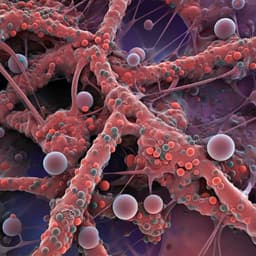
Engineering and Technology
3D photophoretic aircraft made from ultralight porous materials can carry kg-scale payloads in the mesosphere
T. Celenza, A. Eskenazi, et al.
This groundbreaking research by Thomas Celenza, Andy Eskenazi, and Igor Bargatin unveils the design of 3D photophoretic aircraft that can soar high in Earth's mesosphere and Mars's atmosphere. With the ability to transport kilogram-scale payloads using ultralight materials, this study not only presents a theoretical lift model but also demonstrates the feasibility of achieving significant payloads at extreme altitudes.
~3 min • Beginner • English
Introduction
The study addresses the challenge of sustained flight in very thin atmospheres, notably Earth’s mesosphere (∼50–80 km) and high altitudes on Mars, where conventional aircraft and balloons are ineffective and satellites cannot sample in situ. Cooling and contraction of the upper atmosphere and the need to better constrain mesospheric dynamics motivate new long-duration airborne platforms. Prior centimeter-scale “nanocardboard” microflyers leverage photophoretic lift via Knudsen pumping through porous plates but are limited in payload and operational pressure range. This work proposes much larger, many-meter-scale, 3D photophoretic vehicles with porous sidewalls and a small outlet nozzle. The 3D geometry draws ambient air through sun-heated, CNT-coated, transparent alumina walls into an inner chamber and expels it through a nozzle, increasing jet speed, lift, and operational pressure range. The research question is whether such 3D photophoretic aircraft, built from ultralight porous materials, can achieve sustained mesospheric flight and carry gram- to kilogram-scale payloads, and what geometries and microchannel parameters optimize performance across altitudes.
Literature Review
The paper builds on prior work showing: (i) constraints and scientific importance of measurements in the mesosphere (e.g., upper-atmosphere cooling, contraction, and implications for satellite drag); (ii) challenges of high-altitude Mars flight despite Ingenuity’s near-surface success; (iii) photophoretic levitation of ‘nanocardboard’ plates—ultralight, porous alumina sandwich structures with CNT-absorbing layers that produce Knudsen-pump-driven gas flows and downward jets under illumination; (iv) analytical tools developed for solid Mylar–CNT composite disks. These works establish photophoresis as a viable light-driven propulsion mechanism in low-pressure environments and motivate scaling to larger, 3D geometries to increase lift and expand operating conditions.
Methodology
- Concept and geometry: Consider 3D hollow, axisymmetric vehicles (sphere, cone, rocket) with porous alumina (nanocardboard) sidewalls coated on the inner surface with CNTs. Incident light passes through alumina, is absorbed by CNTs, heats the inner wall, and drives Knudsen pumping from the cooler exterior to the warmer interior. Mass flows into the chamber through the walls and exits via a small nozzle, producing a jet and lift.
- Lift model: Derived an interpolative lift expression valid across Reynolds numbers by summing a viscous (Stokes-like) term with an inertial (momentum/actuator disk) term: F ≈ C1·(viscous term with μ, D, and wall through-flow velocity) + C2·(ρ·A_nozzle·v_jet^2). The expression captures low-Re behavior (linear with μ and through-flow velocity) and high-Re behavior (quadratic with jet velocity). The nozzle area is A = πr^2, and D is the characteristic size.
- CFD validation: Performed finite-element CFD in ANSYS Fluent using axisymmetric models (k–ω with low-Re corrections) across geometries and sizes. Simulations spanned outlet jet/through-flow velocities from ~10^-6 m/s up to ~1–100 m/s and atmospheric conditions up to 80 km altitude (with 0, 40, 70 km detailed in SI). Reaction forces on the control boundaries (equal to lift) were computed and fitted to the two-term model to extract geometry-dependent coefficients.
• Geometries and sizes: sphere, cone, rocket; D = 1 cm, 5 cm, 10 cm considered in fits.
• Altitudes: 0 km, 40 km, 70 km; air properties set from standard atmosphere tables.
• Mesh and domain: Large external domain with refined inner domain; 2D axisymmetric meshes with ~2×10^5 elements after convergence analysis.
- Knudsen-pump and thermal model: Extended nanocardboard theory to 3D. Derived flow-through velocity across porous walls from a combined pressure-driven and thermal creep relation, with constants fitted to rarefied gas data and including temperature- and pressure-dependent mean free path (Knudsen number), effective thermal conductivities, and heat-transfer pathways (through channel air, alumina, and trapped internal air). A heat balance related absorbed solar flux (albedo contribution and orientation considered) to wall temperature difference ΔT, enabling calculation of through-flow velocity v_through and exit jet velocity v_jet via mass conservation v_jet = (S_total/A_nozzle)·v_through.
- Parameter optimization: Implemented MATLAB code to parametrize and optimize across geometric and microstructural variables to (a) minimize operating altitude (i.e., lowest altitude for zero payload) and (b) maximize payload at a given altitude.
• Design variables: nanocardboard channel width A, channel height L, nozzle radius r; geometry scale D (sphere/ cone diameter, rocket length).
• Atmospheric model: Empirical fits for T(h), P(h), ρ(h), and μ(h) via standard atmospheric data (polynomial fits and Sutherland’s law), valid up to ~80 km.
• Illumination: Baseline 1000 W/m^2; sensitivity at 500 W/m^2 also evaluated.
• Outputs: Lift via the fitted two-term model with coefficients C1, C2; payload computed as lift minus structural weight (areal-density baseline ~1 g/m^2 for thin nanocardboard, plus alumina volume additions with thicker L); area ratios S_total/A_nozzle and areal density limits explored.
- Fitted coefficients: From 27 CFD cases (3 geometries × 3 D × 3 altitudes), average coefficients were order-unity:
• Sphere: C1 ≈ 1.2, C2 ≈ 0.9
• Cone: C1 ≈ 1.3, C2 ≈ 0.9
• Rocket: C1 ≈ 1.4, C2 ≈ 0.4
- Theoretical limits: Derived an order-of-magnitude upper bound on allowable sidewall areal density in high-Re limit of ~0.004 kg/m^2 (≈4 g/m^2), comparable to, but above, typical experimental nanocardboard areal densities (~1 g/m^2).
Key Findings
- 3D photophoretic geometry effectiveness: Using porous sidewalls to draw in ambient air and a nozzle to form a faster jet substantially increases lift and broadens the operating pressure/altitude range relative to planar plates.
- Operating altitude and payload:
• Minimum altitude for zero payload: ~55 km on Earth (assuming nanocardboard sidewalls and optimal parameters).
• Maximum payload at 80 km altitude (D ≈ 10 m): sphere ≈ 540 g, cone ≈ 780 g, rocket ≈ 1020 g. Kilogram-scale payloads are feasible with ~10 m-scale vehicles; achieving 1 kg at 80 km is possible for a 10 m rocket (~1.02 kg) and requires D ≈ 11.5 m (cone) or ≈14 m (sphere) per figure notes.
- Optimal porous microstructure parameters:
• For minimum-altitude optimization (55–60 km, zero payload): A ≈ 0.20 mm, L ≈ 0.21 mm.
• For maximum payload optimization at 80 km: A ≈ 0.90 mm, L ≈ 0.91 mm.
These values are of the same order across geometries and sizes, indicating designs can serve both low-altitude levitation and higher-altitude payload carriage.
- Areal density limits:
• Typical maximum areal density tolerated by lift: ≈7.1 g/m^2 for small D = 10 cm aircraft and ≈5.5 g/m^2 for large D = 10 m aircraft, approaching the theoretical upper limit (~4 g/m^2) in the high-Re regime.
• Larger aircraft that carry ≥1 g payload stabilize near ~5.5 g/m^2 permissible areal density, underscoring the need for ultralight porous materials.
- Geometry comparison:
• For a given surface area, maximum payloads are very similar among sphere, cone, and rocket. Differences are minor at large sizes; the sphere is marginally better at the smallest sizes, while the rocket slightly outperforms at D ≈ 10 m in the examples.
- Area ratio constancy:
• Optimal total-surface-area to nozzle-area ratio S_total/A_nozzle is approximately invariant within each mission type: ~23 (range ~17–42) for minimum-altitude designs; ~6 for maximum-payload designs.
• Mass conservation implies v_jet ≈ (S_total/A_nozzle)·v_through, so these ratios set the required jet amplification.
- Illumination dependence:
• Reducing intensity from 1000 to 500 W/m^2 lowers payloads by about 4×, highlighting sensitivity to available sunlight.
- Practical implication: 10 m-scale 3D photophoretic aircraft with nanocardboard-like sidewalls (areal density ~1 g/m^2) could carry up to ~1 kg at ~80 km; lowest feasible Earth altitude is ~55 km with zero payload.
Discussion
The findings demonstrate that transitioning from planar nanocardboard flyers to 3D hollow structures with porous sidewalls and a nozzle significantly enhances lift production via two mechanisms: (i) increased volumetric intake through the walls driven by photophoretic (Knudsen-pump) effects and (ii) momentum augmentation by collimating outflow through a reduced nozzle area, thereby achieving higher jet speeds. The derived lift model, validated by CFD and using order-unity coefficients, reliably spans low- to high-Reynolds-number regimes and supports efficient parametric optimization.
The optimized channel dimensions (A and L) are robust across scales and geometries and remain on the same order despite large pressure changes between 55 km and 80 km, simplifying material design targets. The near-constancy of the S_total/A_nozzle ratio for each mission type provides a clear guideline for nozzle sizing relative to surface area to attain either lowest altitude or highest payload performance. Across large sizes, geometry choice becomes less critical for payload per surface area, allowing designers to prioritize manufacturability and structural considerations.
These results directly address the central question: 3D photophoretic aircraft made of ultralight porous materials can feasibly operate in Earth’s mesosphere and carry sensors comparable in mass to CubeSat-class subsystems. The approach also generalizes to Mars using an appropriate atmospheric model, potentially enabling high-altitude, long-duration flight where rotorcraft are inefficient. The requirement for very low areal density materials underscores the role of nanocardboard-like structures or flexible ultralight membranes for practical implementations.
Conclusion
This work introduces and validates 3D photophoretic aircraft that use porous, CNT-coated alumina sidewalls to draw in ambient air and expel it through a nozzle, enabling lift sufficient for kg-scale payloads at ~80 km with ~10 m characteristic size. A compact lift model bridging viscous and momentum regimes, corroborated by CFD, allows systematic optimization of geometric and microchannel parameters. Optimal channel dimensions are A ≈ 0.2–0.9 mm and L ≈ 0.21–0.91 mm depending on mission (minimum altitude vs. maximum payload), while feasible designs require sidewall areal densities of only a few g/m^2. For Earth, minimum operating altitudes of ~55 km are achievable; at 80 km, payloads of ~0.5–1.0 kg are possible depending on geometry and size. The framework readily extends to Mars, pointing to persistent, low-cost, sensor-bearing aerial platforms in previously inaccessible atmospheric regions (Earth 55–80 km; Mars 20–40 km).
Future work should experimentally demonstrate large-area ultralight porous sidewalls with the required structural integrity; integrate full thermal-optical control, attitude/orientation strategies, and energy storage/harvesting for diurnal cycles; refine CFD and rarefied-gas modeling at very high altitudes; and explore flexible, balloonlike or parachute-based 3D architectures for manufacturability and deployment.
Limitations
- Dependence on illumination: Lift is produced only under sunlight; nighttime descent is expected except during polar day. Payloads are sensitive to available flux (e.g., halving irradiance to 500 W/m^2 reduces payload ~4×).
- Material constraints: Achieving performance requires ultralight porous sidewalls with areal density of only a few g/m^2 and adequate structural robustness over many square meters, which is challenging to fabricate and deploy.
- Model and CFD assumptions: Some CFD cases idealize 100% porous walls and use axisymmetric domains and boundary conditions that may differ from open-atmosphere flow fields. At ~70 km, high-Re fitting (C2) is less certain in some datasets.
- Atmospheric modeling range: Empirical standard-atmosphere fits are used up to ~80 km; above this, composition changes (e.g., atomic oxygen) can invalidate simple ideal gas relations.
- Thermal modeling simplifications: The heat balance and effective conductivities in rarefied regimes involve approximations; orientation, rotation, and partial shading in real flight can alter ΔT and flows.
- Structural/dynamic effects: The study focuses on aerodynamic lift and mass budgets; detailed structural dynamics, gust response, control, and stability are not fully analyzed.
Related Publications
Explore these studies to deepen your understanding of the subject.







